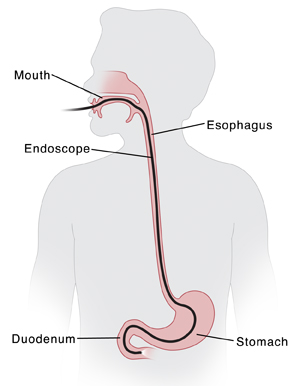Upper GI Endoscopy with Biopsy
Upper GI endoscopy is a test that looks inside your upper GI (gastrointestinal) tract. This includes your food pipe (esophagus) and stomach. And it includes the first part of your small intestine (duodenum). The test is also known as EGD (esophagogastroduodenoscopy). It's done using a tool called an endoscope. This is a long, thin, flexible tube. It has a tiny camera at one end. The test helps find problems such as ulcers, infection, or growths. It can check for celiac disease, gastritis, and esophagitis. During the test, tissue samples (biopsies) may be taken. These are studied for problems.
 |
| With the aid of an endoscope, the doctor can view the inside of the upper GI tract and also take small tissue samples. |
Getting ready for your procedure
Follow any instructions from your healthcare provider.
Tell your provider about any medicines you are taking. This includes prescription and over-the-counter medicines, vitamins, herbs, and other supplements. You may need to stop taking some or all of these before the test.
Follow any directions you’re given for not eating or drinking before the test.
The day of the procedure
The procedure takes about 20 minutes. You'll go home the same day.
Before the procedure begins:
You may be given medicine to help you relax or sleep (sedation). This is given through an IV (intravenous) line placed in a vein in your arm or hand. Your throat may be numbed with a spray or liquid. You'll be given a small plastic guard to protect your teeth. You'll be given oxygen to breathe through small prongs (cannula) that fit just inside your nose. You'll be connected to a machine to watch your heartbeat.
During the procedure:
-
You lie on your left side. The endoscope is placed in your mouth, and it moves down your throat.
-
Air is used to expand your GI tract. This helps the lining be seen more clearly. You may feel pressure or mild pain from the air.
-
The scope sends pictures of your GI tract to a computer screen. The esophagus, stomach, and duodenum are viewed.
-
Problems may be seen and treated. These include bleeding, redness or swelling (inflammation), or growths. Using tools passed through the endoscope, small samples of tissue (biopsy) can be taken. In some cases, small growths can be removed. Other treatments may be done such as stretching (dilating) a narrowed area.
-
The endoscope is then removed.
After the procedure:
The healthcare provider will talk with you later about the results. You’ll rest and be monitored until you can go home. Have an adult family member or friend drive you. Relax for the rest of the day. If you had a biopsy, the results will be ready in about 7 days.
Recovering at home
You’ll likely feel drowsy after the test. A mild sore throat, mild gas, and bloating are normal. Once you're home, follow any instructions you've been given. If you had sedation, don't drive, run machinery, or make major decisions until the next day.
When to call your healthcare provider
Call your healthcare provider if you have any of these:
-
Fever of 100.4°F (38°C) or higher, or as advised by your provider
-
Shaking chills
-
Chest pain
-
Dark-colored stools
-
Severe belly (abdominal) pain that doesn't go away when passing gas
-
Sore throat that doesn’t go away
-
Trouble swallowing
-
Vomiting, especially with blood
-
Any other signs or symptoms indicated by your healthcare provider
Follow-up care
If you had a biopsy, the results will be ready in about 7 days. Your healthcare provider will talk with you about any more testing or treatment that may be needed.
Risks and possible complications
-
Sore throat or hoarseness
-
Bloating
-
Nausea
-
Allergic reaction to the sedative or numbing medicine
-
Bleeding during or after the procedure
-
Too much bleeding from the biopsy site (if a biopsy is done)
-
A hole or tear (perforation) in the lining of the digestive tract
-
Inhaling food or fluid into the lungs (aspiration)
-
Irregular heartbeat or cardiac arrest in someone with heart or lung disease